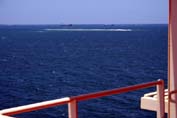
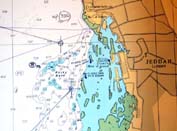 I
beat the alarm out of bed. What an amazing place Jeddah turned out to be and
what a tragedy to never be allowed ashore. Ever.
I
beat the alarm out of bed. What an amazing place Jeddah turned out to be and
what a tragedy to never be allowed ashore. Ever. Jeddah

 I
beat the alarm out of bed. What an amazing place Jeddah turned out to be and
what a tragedy to never be allowed ashore. Ever.
I
beat the alarm out of bed. What an amazing place Jeddah turned out to be and
what a tragedy to never be allowed ashore. Ever.
Predawn city lights twinkled far along the coast in both directions. Daylight revealed oil and gas installations and perhaps a refinery, as well as blocky buildings that may have been apartments. A few tall modern buildings poked up but little else could be seen of the city, away beyond which lay a faintly seen line of ancient grey hills. It was very beautiful. When you looked back out to sea from the dock there were reefs beyond reefs protecting the harbour with only the narrowest passage through which the ships negotiate. I wanted to swim across to the nearest one and have a snorkel around its coral fringes. You should get an idea of the water colours from the photo. The tug boats didn't stir up mud as they worked us in; they stirred up buff-coloured coral sand. As the tide dropped to expose more reef a group of people went out there in a couple of open boat perhaps gathering sea food.
We had come right in through the reefs before the pilot scrambled aboard. Tugs were tucked in behind the beacon and slipped our in pairs to do their job as each ship arrived. When leaving, the Marfret was pulled just clear of the wharf and then the tugs cast off and left us to it. Amazing! And the pilot was off the vessel just beyond the first reef.
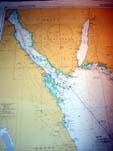 The
port was unbelievably tranquil, smooth and orderly and our visit was over in
four hours. Farewell "Jeddah Islamic Port" and its green, sword-embellished
flag. And so in a mere six hours we were off up the Red Sea on a perfectly
sparkling afternoon and not another ship in sight anywhere. The seal was broken
on the bond store room and passengers reunited with their non-Islamic goodies in
time for the traditional sundowner. I have a feeling that there was an even
greater psychological withdrawal to be satisfied by the resumption of The
Singing Detective. Done! And then the final treat of the evening was to step out
on the deck and say goodbye for the last time to the Southern Cross standing
upright in our wake.
The
port was unbelievably tranquil, smooth and orderly and our visit was over in
four hours. Farewell "Jeddah Islamic Port" and its green, sword-embellished
flag. And so in a mere six hours we were off up the Red Sea on a perfectly
sparkling afternoon and not another ship in sight anywhere. The seal was broken
on the bond store room and passengers reunited with their non-Islamic goodies in
time for the traditional sundowner. I have a feeling that there was an even
greater psychological withdrawal to be satisfied by the resumption of The
Singing Detective. Done! And then the final treat of the evening was to step out
on the deck and say goodbye for the last time to the Southern Cross standing
upright in our wake.
A brilliantly clear, calm Saturday morning dawned with Egypt lying somewhere up to the left as we neared the top of the Red Sea and again ship courses focus on the neck of a funnel, this time the Strait of Gubal leading into the Gulf of Suez. There was another welcome from a solitary land bird, this time a slim, creamy dove with contrasting blocks of darker colours on wing tops and flashes of black and white on the tail - perhaps the same sort that greeted Noah except this one bore no twig of green.

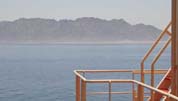 After
breakfast we were opposite Shaker Island and then later could vaguely see both
mainland shores of Egypt and Sinai through the yellow haze with their bare sand
and scarified rock. Oil installation pumping stations, poles and platforms were
stuck in the off-shore sea. Impossibly hazy to photograph. We slowly overtook a
car transporter, the Hual, all morning then later it gained on us and
another freighter ahead and we proceeded up the gulf in a convoy of three. As
the sun climbed the calm water changed to a pristine Indian Ocean blue, for a
time hosting millions of little jelly fish and the occasional working school of
fish. There was a solitary small modern fibreglass fizz-boat out fishing. I
couldn't imagine where it may have come from. To that point there had been no
sign of habitation along either coast except for one group of oil tanks with a
tanker moored below and sun glinting off what may have been windows down on the
shore. Then as the day progressed there were more and more rigs and storage
tanks. A chopper flew across.
After
breakfast we were opposite Shaker Island and then later could vaguely see both
mainland shores of Egypt and Sinai through the yellow haze with their bare sand
and scarified rock. Oil installation pumping stations, poles and platforms were
stuck in the off-shore sea. Impossibly hazy to photograph. We slowly overtook a
car transporter, the Hual, all morning then later it gained on us and
another freighter ahead and we proceeded up the gulf in a convoy of three. As
the sun climbed the calm water changed to a pristine Indian Ocean blue, for a
time hosting millions of little jelly fish and the occasional working school of
fish. There was a solitary small modern fibreglass fizz-boat out fishing. I
couldn't imagine where it may have come from. To that point there had been no
sign of habitation along either coast except for one group of oil tanks with a
tanker moored below and sun glinting off what may have been windows down on the
shore. Then as the day progressed there were more and more rigs and storage
tanks. A chopper flew across.
Horrible streaks of brown of crude oil tracked out on the surface from one of the platforms. Pointing the camera straight down over the bow of the ship I had earlier taken a photograph showing the most wonderfully pristine blue water passing beneath. The sight of the crude was truly shocking by contrast. Black plumes of smoke rose here and there from oil wells along the shore. Not wanting to miss anything, I was all day popping in and out to the deck like a cuckoo in a cuckoo clock and unable to read more than two pages of my book at any one time. My only attempt at resting earlier in the day had been interrupted by a fire drill

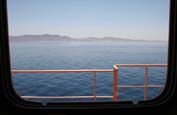 Barren.
Everything ashore looked absolutely barren. There were low areas of yellowish
sand or elevated littoral strips of rounded terrain with indistinct rocky hills
or ranges showing beyond. Some of the ranges had their bases right in the sea.
In one place there was even a patch of pointy illustrated story-book dunes that
you could imagine threading your way through on camel, but where to? "The
abomination of desolation," to quote my grandfather. At dinner time we could see
clumps of blocky structures at intervals along the Sinai coast that Moss's
binoculars revealed to be villages of adobe dwellings of two of three stories
arranged in neat rows at right angles to the shore. A most memorable day
concluded as we eased slowly toward a designated anchoring place for the night.
You might notice numbered circles on the chart. Each one is an anchoring site.
My final photograph shows the sun setting behind a pall of oil fire smoke that
surrounded the entire area of Suez with a nasty yellow haze and a burnt oil
smell, neither of which are captured in the shot. It looked beautiful though and
the tinkling lights of Suez marked four-hundred-thousand souls going about their
multifarious activities of the evening.
Barren.
Everything ashore looked absolutely barren. There were low areas of yellowish
sand or elevated littoral strips of rounded terrain with indistinct rocky hills
or ranges showing beyond. Some of the ranges had their bases right in the sea.
In one place there was even a patch of pointy illustrated story-book dunes that
you could imagine threading your way through on camel, but where to? "The
abomination of desolation," to quote my grandfather. At dinner time we could see
clumps of blocky structures at intervals along the Sinai coast that Moss's
binoculars revealed to be villages of adobe dwellings of two of three stories
arranged in neat rows at right angles to the shore. A most memorable day
concluded as we eased slowly toward a designated anchoring place for the night.
You might notice numbered circles on the chart. Each one is an anchoring site.
My final photograph shows the sun setting behind a pall of oil fire smoke that
surrounded the entire area of Suez with a nasty yellow haze and a burnt oil
smell, neither of which are captured in the shot. It looked beautiful though and
the tinkling lights of Suez marked four-hundred-thousand souls going about their
multifarious activities of the evening.
Contact us at cole@familycole.net Return to Home Page